
Art photography exhibit highlights bay
HOMESTEAD, Fla.— My toes sink into the warm sand that is oozing between them and a rush of foamy beach water seeps over them, erasing it all as the sand is pulled back into the ocean. Mangrove tree branches cast shadows over me, cooling my face. The water deepens to an emerald green at the horizon, lined by cotton ball-like clouds in a seemingly perfect world.
I close my eyes and feel the sun beaming away my cares.
Wait a minute. I open them. This isn’t Miami Beach. I’m in Homestead and I’m not on the sand either. I’m standing outside an art photography exhibit at the Biscayne National Park Fascell Visitor Center titled “Across the Bay.” The photography is by John Andersen and I just got swept away by one of his photographs.
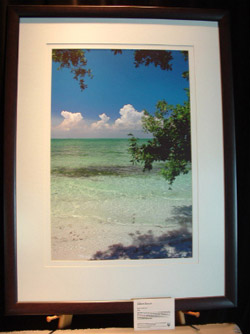 |
“Elliott Beach” framed on display outside of Andersen’s exhibit at the Dante Fascell Visitor Center (Photo by Jannet Jureidini). |
This exhibit is one of several featured year round at the park. This particular one is special because it is tied to the park’s 40th anniversary this year. It is a compilation of photographs taken by Andersen in honor of it.
Taken in 2003, the photograph described is “Elliott Beach” and on its display the artist himself notes that it is his one of his favorites. It is also one of his first photographs taken of Biscayne National Park. The “Elliott Beach” photograph greets visitors at the entrance of the exhibit. It is the only one set aside in a frame on the greeting table, not hanging on the wall with the others.
“This image is very special to me, as it was made during my first visit to Elliott Key as a father. My son was just out of the frame next to me, his 2-year-old toes wiggling in the sand and water,” Andersen said.
At first glance, the photographs inside look like paintings hanging on the wall. However, a closer look at these far too realistic “paintings” tells of the photographer’s talent at hand.
It seems as if they’ve always been there at the Visitor Center just for adornment of the theater room. They fit right in with the tropical theme, as visitors watch the park orientation video program and its underwater journey’s of the coral reefs.
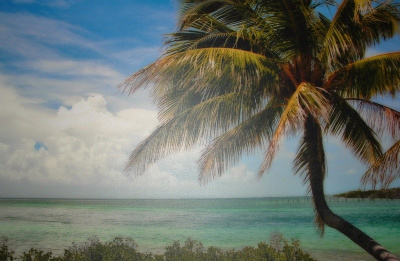 |
“Chita View” on display inside the exhibit at the Dante Fascell Visitor Center (Photo by Jannet Jureidini). |
As others are watching the program, a visitor whispers to a friend about her favorite aspects of the photograph “Chita View,” which stood out the most to her. At first, she also thought it was a painting.
“The palms, the colors of the water, the emerald, the blues,” first-time visitor, Dana Peralta, said.
She came to the park because her nephew’s birthday celebration happened to be at the park.
“It’s wonderful, I didn’t even know that it was here,” said Peralta. “We live here close enough and I didn’t even know.”
In the photograph, Andersen illustrates the north shore of Boca Chita Key as one of his favorite places to look out into the water, due to the view of the Miami skyline that can usually be seen from this spot.
“Standing on this spot, I’m always reminded of the saying ‘Same planet, different world,’” he noted.
Another photograph captures my attention again as I am transfixed in awe of the waves in the water at its foreground, it makes me almost want to reach out and dip my fingers in it. I almost want to check if this is some kind of three dimensional painting, but it’s really just a photograph. I pass my fingers lightly over the water and all I get back is a canvas’ texture.
| “Emerald Bay” on display in the fine art photography exhibit. This image is one of Andersen’s most recent photographs, taken in 2008 (Photo by Jannet Jureidini). | 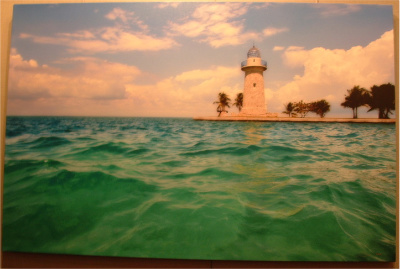 |
One of Andersen’s 2008 images, this photograph is “Emerald Bay” and in its background is the Boca Chita lighthouse. He wanted to make a one-of-a-kind shot of this “iconic structure,” so he improvised.
“I placed my camera on top of the water to make this shot,” he said. “The bay’s beautiful color, courtesy of an incoming tide, draws you into the image of the Boca Chita lighthouse.”
A first-time visitor from Miami, Jimmy Slusher, was unaware of the park. He just wanted to get out of Miami and came upon the park while driving and then followed signs for it.
Passing through the exhibit he was fascinated by the serenity in the photograph “Stiltsville.” The overcast weather in the photo, contributed to the light blues and grays on the water surrounding the building on the northern side of the national park.
“As I photographed this image, just enough light from a few beams of sun illuminated one of these few remaining stilt buildings,” Andersen said.
Art is all about interpretation, and what others can take away from it. Slusher found peace in the loneliness of the photograph.
“It looks alone, isolated, away from everything, which is what a lot of people want— to get away,” Slusher said.
The photograph ironically symbolized exactly what he was doing, trying to get away from it all.
When asked what he enjoyed most about the park he responded, “to get back to what Florida originally looked like and see what it’s like as opposed to the tourist area, we just wanted to get away from that and see what Florida kind of use to be.”
| “Stiltsville” one of Andersen’s photographs on display (Photo by Jannet Jureidini). | 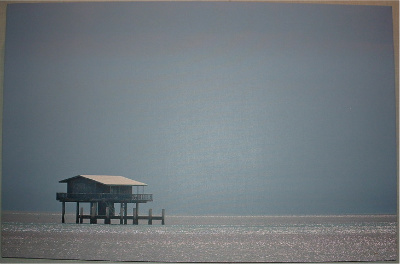 |
These exhibits and the work of the artists are of great value to national parks in general. Gary Bremen, exhibit coordinator for Biscayne National Park, revealed that they are crucial to the establishment of a national park.
“National parks when they were first established were largely due to the artists,” Bremen said.
In the days before Google and being able to look things up on the internet, Bremen said artists were even more integral to the parks. Those that were deciding in Washington whether an idea for a national park should go through relied on photography and paintings.
“They had to be convinced by artists because if it weren’t for artists they would have no idea what it looked like, because those Washington lawmakers back then never traveled to see anything like these places,” Bremen said.
Biscayne National Park is continuing that trend, not necessarily for lawmakers anymore, but for the visitors.
“Those images can travel the way the park can’t, so somebody in Idaho gets to see on a website that Biscayne National Park is a pretty place, so it kind of spreads the message that way,” Bremen said.
For the locals he says the art exposes them to different aspects of the park they otherwise might not have known about.
| A park visitor gazes at Biscayne Bay from the Dante Fascell Visitor Center second floor porch (Photo by Jannet Jureidini). | 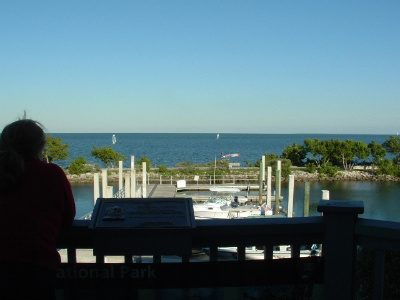 |
“The art openings and the shows themselves draw new audiences,” Bremen said. “They might not be a national park lover, but they’re a photography lover or a John Andersen Fan.”
When people come to Biscayne National Park to see the art, they then realize that they have many other activities, such as scuba diving. Something they may not have discovered if it wasn’t for an art exhibit. The exhibits then incline them to come back again. They also get to explore the park’s beauty and experience the art firsthand.
Particularly, a co-worker recommended Andersen’s photography to Bremen. Once he took a look at the artist’s work he said the boldness of the colors and the way that the photographs were shot stood out to him.
“His images, a lot of them are an object, a Stiltsville house or a sailboat that is relatively small in the picture and it’s lots of sky and water around it,” Bremen said. “Personally that appeals to me, I like that sense of feeling small in the world, it puts me in my place.”
Bremen tries to keep all of the exhibits unique. He says he gets a lot of photographers that want to show their work, but he tries to keep them different. He mixes it up between photographers and artists as well.
“The fact that he was going to do all of his pieces on canvas was a little bit different than any photography that we’ve had here,” Bremen said.
The next featured artist, Vanessa Bryson, will be doing watercolors on silk— to give you a taste of the distinctiveness of these exhibits.
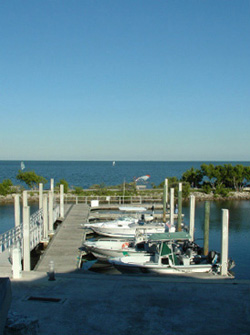 |
The view of Biscayne Bay from the dock of the Dante Fascell Visitor Center (Photo by Jannet Jureidini).
|
Bremen already has the gallery booked through early summer of 2010, and he tries to keep all the exhibits as diverse as possible.
“I like to have things that look different so it’s not always eight by 10 photographs in little black frames or something like that,” he said. “The subject matters always changing, I want the gallery to give different impressions.”
Emma Anters, a new park ranger, brought me back to the first photograph when she described it as her favorite photograph in the exhibit.
“I was really excited because I thought I would be able to run on the beach when I first came here,” Anters said.
They later told her it was mainly mangrove shoreline, so that wouldn’t be happening much. After a bit of disappointment she learned that mangroves were really important for filtering out some of the pollutants in the water and for fish survival.
She said the photograph is a “real treat” for those that don’t have the resources to get out there on a boat. On this day the glass bottom boat used for the tours was also broken, so the treat was even tastier.
“It gives you the impression that you’re on a beach with the mangrove trees coming out to the side. You can’t see anything wrong and it just looks like paradise.”
| A windsurfer crosses Biscayne Bay near the Dante Fascell Visitor Center at the park (Photo by Jannet Jureidini). | 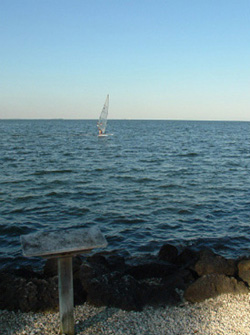 |
Getting away from metropolitan society is part of this natural wonder’s purpose. You can experience it vicariously through the exhibits or on its very shores. I picture my frozen daiquiri in hand, the sand coating my toes and the cool water rushing over them, as I close my eyes again fading back into my pictorial tropical paradise.
If You Go
The art exhibits at Biscayne National Park are featured inside the Dante Fascell Visitor Center Gallery, on the second floor.
Address: 9700 SW 328 St., Homestead, Fla. 33033.
| Andersen’s photographs are displayed along the walls of the theater in the Dante Fascell Visitor Center (Photo by Jannet Jureidini). | 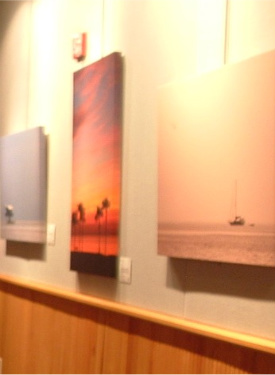 |
Hours: Dante Fascell Visitor Center – daily 9 a.m. to 5 p.m.
Directions from the North through the Florida Turnpike: Merge onto Florida’s Turnpike South (FL-821 South). Take the SW 288th Street / Biscayne Drive exit, Exit 5 (follow signs for Biscayne National Park). Turn left onto SW 288th Street (Biscayne Drive), later turn right onto SW 137th Avenue (Speedway Boulevard).Turn left onto SW 328th Street (North Canal Drive). Follow the road for a few miles, and the entrance will be on your left.
Parking: The Dante Fascell Visitor Center is located on Convoy Point, with free parking available in front of the visitor center. The other islands are only accessible by boat.
Food: There is a gift shop that has food and drinks available for purchase, but the selection is very small in a tiny refrigerator. The best option for visitors is to bring their own food and enjoy it in the picnic area.
Tours and Facilities: Canoe and kayak rentals, as well as guided tours are available from the park’s concessionaire at Convoy Point. Call 305-230-1100 for more tour information.
Andersen’s photographs can be purchased from the artist himself. Contact him at 305-233-0065 or visit http://www.imagesbyjda.com for more information.
For more information on the park and its exhibit schedules visit: http://www.nps.gov/bisc/
| A framed Andersen image is displayed on an easel at the Dante Fascell Visitor Center (Photo by Jannet Jureidini). | 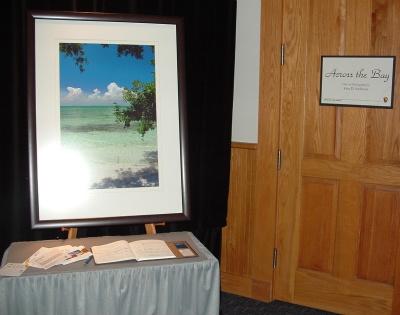 |

Comments are Closed